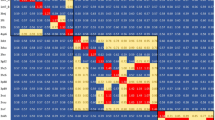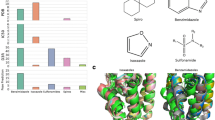Abstract
The Drug Design Data Resource (D3R) Grand Challenges are blind contests organized to assess the state-of-the-art methods accuracy in predicting binding modes and relative binding free energies of experimentally validated ligands for a given target. The second stage of the D3R Grand Challenge 2 (GC2) was focused on ranking 102 compounds according to their predicted affinity for Farnesoid X Receptor. In this task, our workflow was ranked 5th out of the 77 submissions in the structure-based category. Our strategy consisted in (1) a combination of molecular docking using AutoDock 4.2 and manual edition of available structures for binding poses generation using SeeSAR, (2) the use of HYDE scoring for pose selection, and (3) a hierarchical ranking using HYDE and MM/GBSA. In this report, we detail our pose generation and ligands ranking protocols and provide guidelines to be used in a prospective computer aided drug design program.






Similar content being viewed by others
References
Gathiaka S, Liu S, Chiu M, Yang H, Stuckey JA, Kang YN et al (2016) D3R Grand Challenge 2015: evaluation of protein–ligand pose and affinity predictions. J Comput Aided Mol Des 30:651–668
Gaieb Z, Liu S, Chui M, Yang H, Shao C, Gathiaka S et al (2016) Drug Design Data Resource Grand Challenge 2 Dataset: Farnesoid X Receptor. Drug Design Data Resource. University of California, San Diego
Jin L, Feng X, Rong H, Pan Z, Inaba Y, Qiu L et al (2013) The antiparasitic drug ivermectin is a novel FXR ligand that regulates metabolism. Nat Commun 4:1937
Morris GM, Huey R, Lindstrom W, Sanner MF, Belew RK, Goodsell DS et al (2009) AutoDock4 and AutoDockTools4: automated docking with selective receptor flexibility. J Comput Chem 30:2785–2791
Schneider N, Lange G, Hindle S, Klein R, Rarey M (2013) A consistent description of HYdrogen bond and DEhydration energies in protein–ligand complexes: methods behind the HYDE scoring function. J Comput Aided Mol Des 27:15–29
O’Boyle NM, Banck M, James CA, Morley C, Vandermeersch T, Hutchison GR (2011) Open Babel: an open chemical toolbox. J Cheminf 3:33
SeeSAR v5.5, BioSolveIT GmbH, St.Augustin, Germany. http://www.biosolveit.de/SeeSAR
Bietz S, Urbaczek S, Schulz B, Rarey M (2014) Protoss: a holistic approach to predict tautomers and protonation states in protein–ligand complexes. J Cheminf 6:12
Berman HM, Westbrook J, Feng Z, Gilliland G, Bhat TN, Weissig H et al (2000) The Protein Data Bank. Nucleic Acids Res 28:235–242
De Lano W (2002) The PyMOL molecular graphics system. DeLano Scientific, Palo Alto. http://www.pymol.org
Dessau RB, Pipper CB (2008) [‘‘R"--project for statistical computing]. Ugeskr Laeger 170:328–330
Pettersen EF, Goddard TD, Huang CC, Couch GS, Greenblatt DM, Meng EC et al (2004) UCSF Chimera—a visualization system for exploratory research and analysis. J Comput Chem 25:1605–1612
Olsson MH, Sondergaard CR, Rostkowski M, Jensen JH (2011) PROPKA3: Consistent treatment of internal and surface residues in empirical pKa predictions. J Chem Theory Comput 7:525–537
RDKit, Open-source cheminformatics. http://www.rdkit.org
Reulecke I, Lange G, Albrecht J, Klein R, Rarey M (2008) Towards an integrated description of hydrogen bonding and dehydration: decreasing false positives in virtual screening with the HYDE scoring function. ChemMedChem 3:885–897
Genheden S, Ryde U (2015) The MM/PBSA and MM/GBSA methods to estimate ligand-binding affinities. Expert Opin Drug Discov 10:449–461
Wang J, Wang W, Kollman PA, Case DA (2006) Automatic atom type and bond type perception in molecular mechanical calculations. J Mol Graph Model 25:247–260
Wang J, Wolf RM, Caldwell JW, Kollman PA, Case DA (2004) Development and testing of a general amber force field. J Comput Chem 25:1157–1174
Phillips JC, Braun R, Wang W, Gumbart J, Tajkhorshid E, Villa E et al (2005) Scalable molecular dynamics with NAMD. J Comput Chem 26:1781–1802
Hornak V, Abel R, Okur A, Strockbine B, Roitberg A, Simmerling C (2006) Comparison of multiple Amber force fields and development of improved protein backbone parameters. Proteins 65:712–725
Onufriev A, Bashford D, Case DA (2004) Exploring protein native states and large-scale conformational changes with a modified generalized born model. Proteins 55:383–394
Weiser J, Shenkin P, Still WC (1999) Approximate atomic surfaces from linear combinations of pairwise overlaps (LCPO). J Comput Chem 20:217–230
Trott O, Olson AJ (2010) AutoDock Vina: improving the speed and accuracy of docking with a new scoring function, efficient optimization, and multithreading. J Comput Chem 31:455–461
Acknowledgements
MR is recipient of a MNESR fellowship. We thank Dr. Marcus Gastreich and BioSolveIT GmBH for providing SeeSAR.
Author information
Authors and Affiliations
Corresponding author
Additional information
Manon Réau and Florent Langenfeld have contributed equally to this study.
Electronic supplementary material
Below is the link to the electronic supplementary material.
Rights and permissions
About this article
Cite this article
Réau, M., Langenfeld, F., Zagury, JF. et al. Predicting the affinity of Farnesoid X Receptor ligands through a hierarchical ranking protocol: a D3R Grand Challenge 2 case study. J Comput Aided Mol Des 32, 231–238 (2018). https://doi.org/10.1007/s10822-017-0063-0
Received:
Accepted:
Published:
Issue Date:
DOI: https://doi.org/10.1007/s10822-017-0063-0




